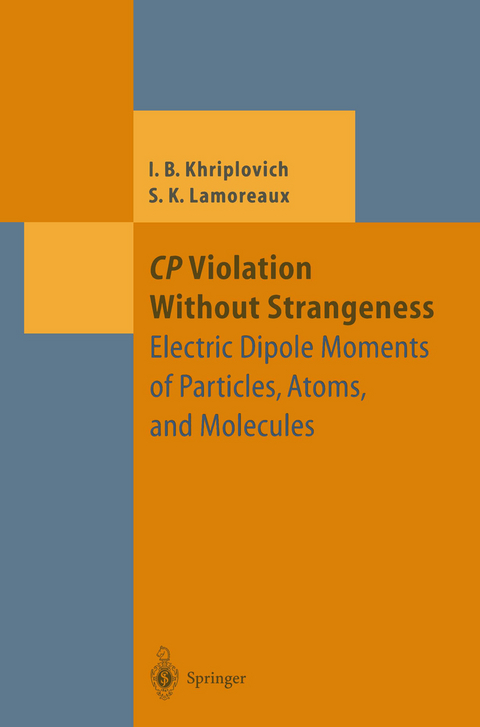
CP Violation Without Strangeness
Springer Berlin (Verlag)
978-3-642-64577-8 (ISBN)
1. Introduction.- 1.1 Overview of CP Violation Without Strangeness.- 1.2 The Neutron Electric Dipole Moment: Early History.- 1.3 Molecular Electric Dipole Moments and CP Violation.- 1.4 T-Odd Effects Without CP Violation.- 2. Kinematics of Discrete Symmetries.- 2.1 CPT Theorem: Intuitive Approach.- 2.2 T-Even and T-Odd Electromagnetic Multipole Moments.- 2.3 General Structure of Four-Fermion Operators.- 3. General Features of EDM Experiments.- 3.1 Interaction of an EDM with an Electric Field.- 3.2 Ground State Optical Pumping and Detection of Atomic Polarization.- 3.3 Electric Fields and Coherence Times in Various Systems.- 3.4 Magnetic Field Control and Generation.- 3.5 Systematic Effects.- 4. The Search for the Neutron EDM.- 4.1 Properties of the Neutron.- 4.2 Interaction of Neutrons with Matter.- 4.3 Neutron Beam EDM Experiments.- 4.4 Ultracold Neutrons.- 4.5 Neutron EDM Measurements with Stored Ultracold Neutrons.- 4.6 The Future: Superfluid He Neutron EDM with a 3He Comagnetometer.- 4.7 Comparison of Experimental Techniques.- 5. Theoretical Predictions for Neutron and Electron Dipole Moments.- 5.1 The CP-Violating ? Term in Quantum Chromodynamics.- 5.2 Predictions of the Standard Model for Dipole Moments.- 5.3 Spontaneous CP Violation in the Higgs Sector.- 5.4 Phenomenological Approach.- 6. EDM Experiments with Paramagnetic Atoms.- 6.1 The Shielding Problem.- 6.2 Enhancement of the Electron EDM in Paramagnetic Atoms.- 6.3 Overview of Paramagnetic Atom Experiments.- 6.4 The Cs EDM Experiment.- 6.5 The T1 EDM Experiment.- 6.6 Future Prospects for Improving the Electron EDM Limit.- 6.7 EDM Limits of Some Other Elementary Particles.- 7. EDM Experiments with Diamagnetic Atoms.- 7.1 Shielding in the 1S0 System.- 7.2 The 129Xe EDM Experiment.- 7.3 The 199Hg EDMExperiment.- 7.4 3He - 129Xe Comparison.- 8. Atomic Calculations.- 8.1 Wave Function of an Outer Electron at Short Distances.- 8.2 The Electron EDM in Paramagnetic Heavy Atoms.- 8.3 CP-Odd Electron-Nucleon Interaction.- 8.4 Electron EDM in Diamagnetic Atoms.- 8.5 CP-Odd Nuclear Moments.- 9. T Violation in Molecules.- 9.1 Enhancement of an Applied Field by a Polar Molecule.- 9.2 TIF Beam Experiments.- 9.3 What Have We Learned from the TIF Experiment?.- 9.4 Paramagnetic Molecules.- 9.5 What Will Be Gained from Experiments with Paramagnetic Molecules?.- 10. CP-Odd Nuclear Forces.- 10.1 CP-Odd Mixing of Opposite-Parity Nuclear Levels.- 10.2 Nuclear Moments Induced by T- and P-Odd Potentials.- 10.3 Enhancement Mechanisms for T- and P-Odd Nuclear Multipoles.- 10.4 Theoretical Predictions and Implications.- 11. What Do We Really Know About T -Odd, but P-Even Interactions?.- 11.1 Long-Range Effects.- 11.2 TOPE Fermion-Fermion Interactions.One-Loop Approach.- 11.3 TOPE Fermion-Fermion Interactions.Two-Loop Approach.- 11.4 Conclusions on TOPE eN and NN Interactions.- 11.5 T-Odd ? Decay Constants.- References.
| Erscheint lt. Verlag | 18.9.2011 |
|---|---|
| Reihe/Serie | Theoretical and Mathematical Physics |
| Zusatzinfo | XII, 230 p. |
| Verlagsort | Berlin |
| Sprache | englisch |
| Maße | 155 x 235 mm |
| Gewicht | 381 g |
| Themenwelt | Naturwissenschaften ► Physik / Astronomie ► Atom- / Kern- / Molekularphysik |
| Naturwissenschaften ► Physik / Astronomie ► Hochenergiephysik / Teilchenphysik | |
| Schlagworte | Atom • atomic and molecular spectroscopy • CP-Violation • electric dipole moments • electron • Electroweak Interactions • elementary particle • Kinematics • Magnetic field • Molecule • Neutron • Neutrons • Nucleon • Particle physics • particles • polarization • Potential • Quantum Chromodynamics • scattering • standard model • time-reversal |
| ISBN-10 | 3-642-64577-1 / 3642645771 |
| ISBN-13 | 978-3-642-64577-8 / 9783642645778 |
| Zustand | Neuware |
| Haben Sie eine Frage zum Produkt? |
aus dem Bereich


